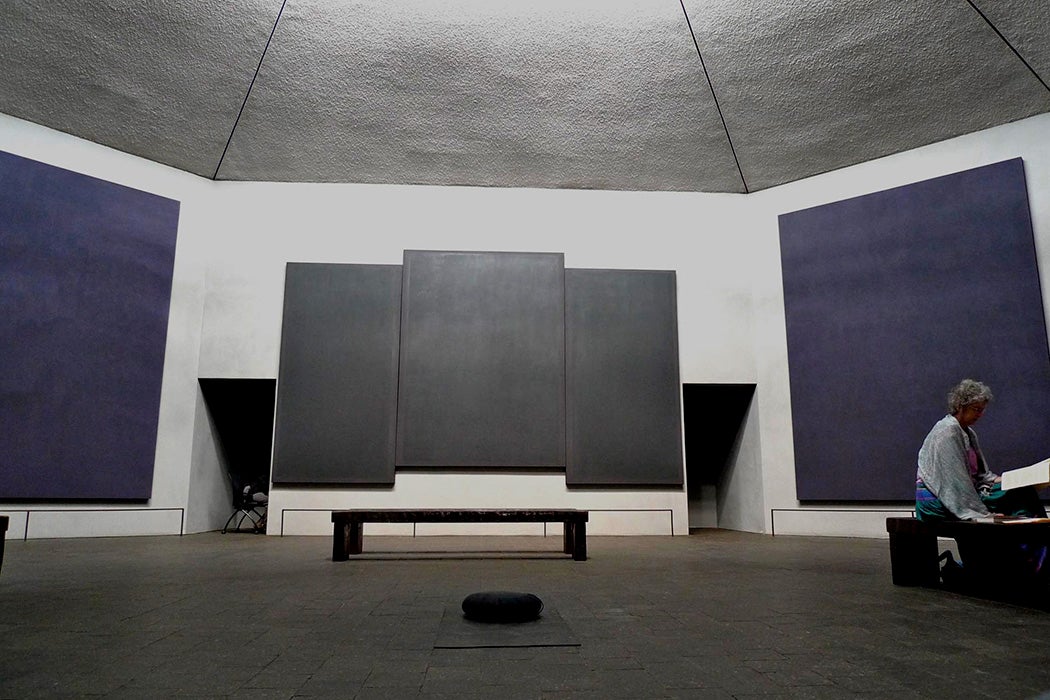A nondescript brick building in Houston, Texas, houses one of the twentieth century’s boldest reimaginings of spiritual space. Entering through two black doors, visitors to the Rothko Chapel are surrounded by fourteen colossal black paintings installed in an octagonal room. A closer look reveals that they are all distinct, and none is in fact pure black, instead containing varying colors and textures in their shadowy surfaces. Some appear like nightshade; others have a deep oxblood tone. A skylight overhead gives the light a constantly changing quality, so as clouds pass or the sun sets, the paintings continue to transform.
The non-denominational space is both a respite and a masterpiece of modern art. It was among the last works finished by the artist Mark Rothko. He killed himself a year before the chapel was dedicated in 1971 as “a sacred place open to all, every day.” That year, Dominique de Menil, who commissioned the chapel with her husband John (together they also founded the neighboring Menil Collection), considered how the late painter created such depth with a sparse palette in Art Journal:
Within the severe limitations he had set for himself, Rothko worked relentlessly. A careful look at any of the black fields reveals successive stages. At first, the field occupied only the central part—an opening in a wall into the night. Step by step, the field was enlarged, leaving only a narrow margin of color. The night had invaded the wall.
The Menils were most interested in how Rothko engaged with the spiritual in his art—the “Spirit of Myth, which is generic to all myths at all times,” as he once put it. In 1964, he agreed not just to contribute paintings to the chapel but to collaborate on the architecture that would hold them. In Perspectives of New Music, music historian Steven Johnson writes that Rothko “regarded his Chapel commission as the major event in his career. His paintings were to hang by themselves in a space he had designed, and they would be viewed in a context that would emphasize humanistic meaning over abstraction.”
He initially worked with architect Philip Johnson, another leading figure of American modern expression, yet they conflicted over the design, so the angular structure was completed with architects Howard Barnstone and Eugene Aubry. Rothko had very specific ideas of how he wanted visitors to feel in the space. For instance, in positioning one painting at the entrance across from another in the apse, “Rothko wanted to reproduce the tension that he had experienced during a visit to the Byzantine basilica church of St. Marian Assunta in Torcell,” explains philosophy of religion scholar Wessel Stoker in the International Journal for Philosophy of Religion. While Rothko did not offer any religious context for the paintings themselves—although the repeated use of triptychs echoes the Holy Trinity—he “did tell Dominique de Menil about his intense emotional experience during this visit.”
From its opening, some visitors were baffled by this chapel of strange darkness. A common question over the years has been: “Where are the paintings?” Many have found in the Rothko Chapel a meditative calm. “Among the comments written in the guest book kept in the chapel’s foyer, the most frequently used word is ‘peace,’” writes the late Rothko biographer James E. B. Breslin in The Threepenny Review.
Weekly Newsletter
Others, however, have perceived in the paintings hints of Rothko’s personal darkness, which in his final years included upheaval in his family life and his health. Literary historian William E. Cain observed in the Southwest Review that it is said of these canvases that they “are saturated with death; they are representations of the void, stark and remorseless but, somehow, uplifting evocations of emptiness: they absorb us into themselves the longer we gaze at them.”
For those who take the time to really look at them, the paintings offer quiet reflection. The Rothko Chapel still serves the spiritually diverse community of Houston, from religious services to private prayer and meditation. Last March, the chapel closed for renovations as part of a capital project called Opening Spaces aimed at preserving this unique sacred space. It is planned to reopen this June with a revamped skylight, entryway, and lighting to enhance how illumination interacts with the paintings, as well as upgrades to protect the art so that it will continue to be as Rothko intended. In the stillness of the Rothko Chapel, all are invited to have peace or silence, with the paintings providing an enigmatic portal to contemplation.
Support JSTOR Daily! Join our new membership program on Patreon today.







